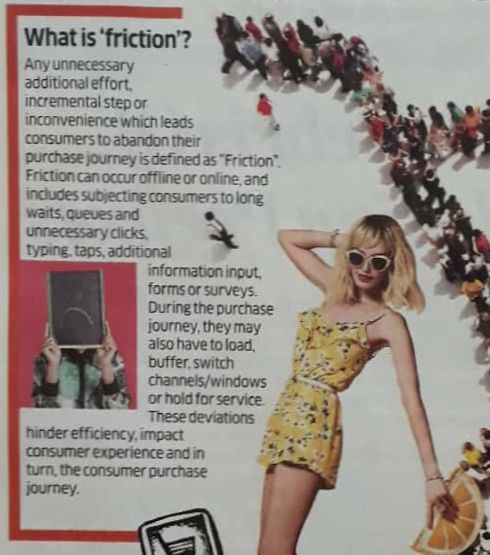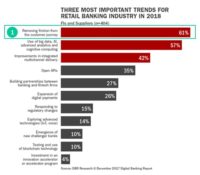Over the years I’ve bought a wide range of products and services from banks, insurers, etailers, colleges, publishers, brick-and-mortar stores, hardware and software companies, TELCOs, airlines and travel agencies.
My experience as a customer ranges from delight (Ecommerce and Travel) through to exasperation (Higher Education, Media, and Retail) and indifference (BFSI, Technology and Telecom).
 Poor CX is caused by excessive friction.
Poor CX is caused by excessive friction.
Given below is a working definition of friction:
Friction is the gap between what the user wants to do and what the product wants the user to do.
The term “product” in the above definition is a catch-all and can refer to a website, app, physical store, SAAS, onprem software, etc.
Friction is characterized by any additional effort or incremental step perceived by the customer as unnecessary. By causing inconvenience, friction leads consumers to abandon their purchase journey, which means businesses lose sales.
As explained in the exhibit on the right, friction can occur in both online and physical worlds and is triggered by long queues, excessive data entry, unnecessary clicks, seamy workflows, and other hassles that consumers are subjected to while interacting with a company.
Friction is in turn the symptom of many underlying root causes, which I call “Deadly CX Killers”.
In this post, I’ll describe six deadly CX killers and share my thoughts on how companies can kill them, thereby reducing friction and improving CX.
#1. “What’s CX SheeX?”
Many brands and consumers alike have misconceptions about the meaning of CX.
One, they think Customer Experience equals Customer Service.
They’re wrong.
Customer Experience (CX) refers to the totality of perceptions and related feelings caused by the effect of the customer’s interactions with a supplier’s employees, channels, systems or products (Source: Gartner). It includes touchpoints before and during purchase, delivery, usage, renewal, support, and so on.
Customer Service (CS) is restricted to the after-sales support journey.
Here are a few more differences between Customer Experience and Customer Service:
- CX is not a contractual commitment, whereas CS often is (think TAT, SLA, etc.). In other words, a customer can demand CS and sue a supplier for bad CS but can’t do the same for CX. OTOH, s/he can reward good CX with loyalty, word of mouth, larger ticket size, higher frequency of purchase, and so on.
- CX focuses on making sure nothing goes wrong, whereas CS typically gets involved only when something goes wrong.
- Good CX will largely obviate the need for CS.
In short, CX is a privilege whereas CS is a right.
Therefore, Customer Experience does not equal Customer Service.
Going by this, Amazon and Flipkart are exact opposites:
- Amazon has good Customer Experience but bad Customer Service.
Customer Experience is not same as Customer Service. After enjoying great CX when nothing went wrong in 15+ years, it's only after facing acute delivery problems in the recent past that I realize that Amazon has never provided phone, email or chat support.
— S.Ketharaman (@s_ketharaman) December 15, 2017
- Flipkart has bad Customer Experience but good Customer Service.
Yo @Flipkart @flipkartsupport : Not only is your price (INR 155) above MRP (INR 65) but you also deface the MRP. Not sure if that counts as one or two offences. pic.twitter.com/VUZzRcH059
— Ketharaman Swaminathan (@s_ketharaman) April 15, 2019
(Flipkart resolved my complaint on the basis of my single tweet above.)
Two, they assume that CX is the same as UX or UI.
Again, they’re mistaken.
UI (User Interface) pertains to forms, fields, buttons and other elements on a product, software, website or app.
UX (User Experience) is concerned with the user’s navigation of the various UI elements. While UX is most commonly associated with a digital medium – software, website or app – it could equally well be applicable for a physical product. To reflect this, I find it useful to think of UX as “Usage Experience”.
In short, UI is how it looks whereas UX is how it works.
CX encompasses the totality of the customer’s interactions across digital and analog touchpoints of the brand / company including face-to-face, telephone, and so on. To that extent, it’s useful to think of CX as “Complete Experience”.
UI: Nice-looking form.
UX: Do we need the form?
CX: Enhance customer journey in and out of the software— S.Ketharaman (@s_ketharaman) June 25, 2017
Notwithstanding the above definitions and clarifications, you can still be unsure about the difference between CX and UX, as I was when I read the following tweet by @fztalks:).
#WannaLaugh🙂 I'm still undecided whether this is great CX or great UX:) #WannaCry
https://t.co/XXz6ss0ynL— S.Ketharaman (@s_ketharaman) May 18, 2017
#2. “Does CX have ROI?”
Some companies are not sure whether CX has any ROI whereas others don’t know how to measure the ROI of CX.
Companies in both cohorts can rest assured. CX definitely has ROI and the ROI can be measured.
As I highlighted in How CX Drives Sales, the superior CX of rideshare companies can drive incremental sales in the following ways:
- Every time I need a cab, I order an Uber or Ola
- Whenever I need to go to a new place for the first time, I no longer use my own car because of hassles related to parking and finding the way around unfamiliar places. I simply book an Uber or Ola instead.
By increasing sales, CX delivers ROI for rideshare.
It has the same effect in many other industries.
The ROI of CX can be measured by using the rigorous frameworks available from research firm Gartner / CEB here and here.
#3. “Customer is tech savvy, they will figure out what to do.”
No they won’t. Because competition.
Tech savvy customers will inevitably be using products from other companies. As a result, they will be exposed to good CX and be less likely to tolerate a company with bad CX.
Besides, by virtue of their greater exposure to the market, tech savvy customers will easily be able to find an alternative company with good CX after dumping the one with bad CX.
Therefore, contrary to what makers think, a tech savvy customer will dump a company with poor CX faster than a non-tech savvy customer would.
#4. “If the customer really wants to buy from us, they will make the extra effort.”
 This assumption is not true at all in a free market capitalism.
This assumption is not true at all in a free market capitalism.
For one, in a crowded marketplace, the customer is spoilt for choice and can easily buy from somebody else who has a better CX with less effort.
For another, there’s nothing like “really want to buy”.
As Gartner’s Martin Kihn points out in 4 Forces Shaking Up Marketing Right Now, “Capitalism requires the construction of needs that do not naturally occur”.
A sizeable portion of GDP of any large economy comes from discretionary purchases. They’re not needs or wants but aspirations, which are created by advertising and other marketing motions.
Once a customer abandons their purchase journey due to poor CX, their attention may be drawn by another product and they may never regain the wish to buy the product with poor CX again.
Let alone free markets, the assumption that lies at the heart of this CX killer is not true even in a monopoly. Take, for example, IRCTC, which is the only company authorized to sell train tickets online in India. It’s no secret that the UX of this company’s website leaves a lot to be desired. However, IRCTC helps passengers avoid the unpleasant experience of having to buy train tickets physically by going to a railway station and standing in a line for hours. As a result, it could be argued that IRCTC has a decent CX that compensates for its shoddy UX.
#5. “Are customers so busy they don’t have time to carry out an extra step?”
Even if customers have spare time, it’s their time and they will jolly well do whatever they want with it. Brands are naive if they expect customers to spend their time on navigating through the extra steps in their product or software or website or app. The only right brands have is to expect customers to pay for their product / service.
#6. “It’s the customer’s mistake. Why should we do something about it?”
This is a wrong stand to take unless a customer outrightly abuses you.
Brands should remember that the customer has a full time job doing something other than interacting with their company. So they should cut them slack if they make mistakes while dealing with their app or website or whatever. As Alain Bejjani, CEO of the Middle East conglomerate Majid Al Futtaim, puts it in his interview with McKinsey, “It may not be your fault, but it is your problem.”
Well said @alainbejjani : “It may not be your fault, but it is your problem.” https://t.co/PT5mfXdHWjhttps://t.co/PuOC9mW5JV
— S.Ketharaman (@s_ketharaman) August 18, 2017
How To Kill The Deadly CX Killers
I’ve noticed one interesting thing about what it takes to provide good CX.
Many small companies shy away from it, citing lack of resources. Many big companies say they have too much volumes to do it.
Notwithstanding, there are many small and big companies that do provide great CX.
This can only mean that a company’s attitude towards CX is driven by mindset rather than size.
Ergo, enhancing CX requires the transformation of a company’s mindset such that it slays the aforementioned six deadly CX killers.
While the transformation exercise itself will need to be led by HR and OD, marketing and IT can contribute significantly by surfacing UI, UX and CX defects in all critical customer journeys and implementing the changes required to get rid of them – akin to the CX test drive we did of the online account opening portal of a leading retail bank that led to a manifold increase in the number of customers acquired online.
Ecommerce and Travel companies have been doing this for a long time.
 Retail Banking has recently joined the CX bandwagon. According to The Financial Brand, the industry has placed “remove friction from the customer journey” as its #1 imperative for 2018.
Retail Banking has recently joined the CX bandwagon. According to The Financial Brand, the industry has placed “remove friction from the customer journey” as its #1 imperative for 2018.
I’m very thrilled to hear this.
In an op-ed published by the Journal of Internet Banking And Commerce (JIBC) in 2012, I’d appealed to retail banks to improve their CX. It has taken six long years since then for banks to start taking CX seriously. But I’m glad that the moment has finally arrived. As they say, better late than never!
Hope the other CX laggards follow suit soon.
